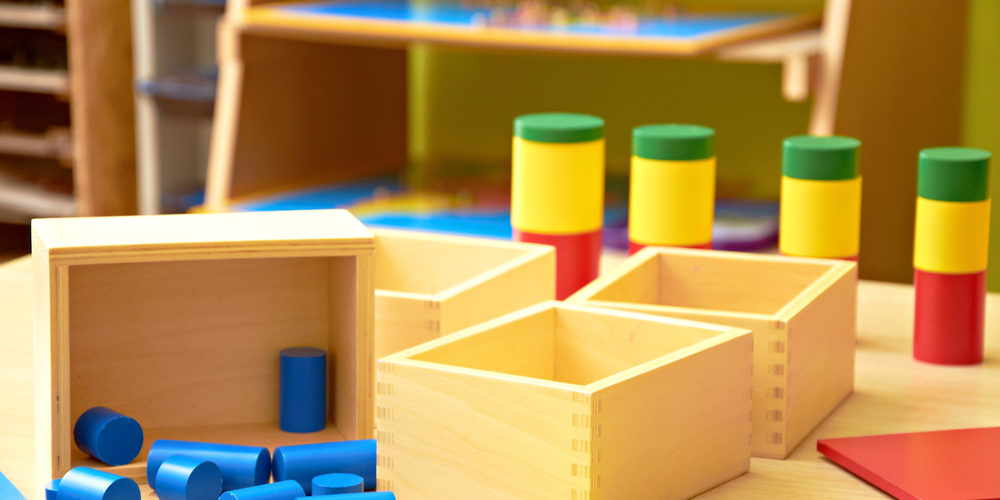Did you know that the Montessori method is not trademarked? That may come as a surprise to you and could present an obstacle. Interestingly, Dr. Maria Montessori never put trademarks on any of the material that she created. This means that anyone can open a Montessori school, even when the curriculum and environment doesn’t match the Montessori method.
That is why you need to know what to look for in a Montessori school. Otherwise, you might enroll your child somewhere Montessori-themed, and it will not be the same.
Let’s begin.
1. Certified Teaching Staff
There should always be a certified Montessori teacher at the head of the classroom and a non-teaching assistant in the classroom. The certified teacher will usually hold a diploma from either the American Montessori Society (AMS) or the Association Montessori Internationale (AMI). Meanwhile, the assistant is there to ensure the environment stays clear of danger and to help supervise outdoor activities.
Observe the teacher when visiting the school in question. Does the teacher move around the smaller groups of students rather than standing in front of the class? Do they observe rather than lead? Do they communicate with the students in a courteous and patient manner?
If the teacher calmly guides and works as a facilitator instead of directing everything, then they are running a Montessori class.
2. High Quality Montessori Materials
One key feature of a great Montessori school is the quality of the materials in the classroom. The materials should cover practical life (including art), sensorial, mathematics, geography, science, and language activities. Only one of every material will be available to the students, so there is always a chance for everyone to work alone.
Most Montessori learning materials are brightly colored and made from wood. Look for the more common Montessori items, including the movable alphabet, sound cylinders, pink tower, puzzle maps, beads, and math checkerboard.
View this post on Instagram
3. A True Montessori Learning Environment
Aside from having Montessori materials available, the environment in the school shouldn’t compare to a public school. A true Montessori program is easy to spot when you know what to look for. Here are some characteristics of a real Montessori school:
- A warm, safe, and welcoming environment from the moment you step through the front doors
- A colorful room full of Montessori materials, art, plants, and child-sized furniture
- Furniture grouped together, not separated
- Organized materials that are displayed at child-height
- Child-friendly toilet facilities
- A life-skills area
- A neatly organized space
- Places where children can work out differences (sometimes called a Peace Chair) or a Watch Chair, where children and parents can observe
Overall, the classroom should feel alive and vibrant, even when the students are quietly working out problems on their own. When you visit the school, you should get a sense that the children are happy.
4. Mixed-Age Classrooms
Dr. Maria Montessori once wrote, “To understand what the older ones are doing fills the little ones with enthusiasm. There is a communication and a harmony between the two that one seldom finds between the adult and the small child.”
A defining feature of Montessori schools is the mixed-age classrooms. This structure gives older students a chance to mentor their younger peers and for the younger students to model more mature children. Role models are crucial to a Montessori classroom, which is why you will find 3-, 4-, and 5-year olds playing together.
5. Dedicated Classwork Time
One question to ask the teacher or administration of the school you’re interested in is: “How long is the uninterrupted work time?” The dedicated period of classwork is traditionally 3 hours long. For example, this segment of time could last between 9:00-12:00 PM. Within that period, children are given freedom to work with the materials, receive lessons, have a snack, and participate in group play.
The 3-hour long period is used for a reason. Children (and adults) need time to explore, ask for guidance, concentrate, and learn on their own.
It’s not like this in traditional schooling, where subjects are broken up into smaller blocks and offered on different days throughout the week. That can disrupt learning. Montessori schools, on the other hand, should have a period of time that allows students the opportunity to truly delve into a subject and learn.
6. Accreditation
When you want to know for certain that a Montessori school abides by the philosophies and methodologies of Maria Montessori, look for accreditation. Schools are not required to affiliate with either the American Montessori Society (AMS) or Association Montessori Internationale (AMI). However, if a school goes out of the way to connect with other institutions teaching the same thing, it’s a sign of legitimacy.
Why? Because the school must provide proof that the teaching staff have been certified and that the curriculum stays true to Montessori principles.
Looking For a Montessori School?
Now that you know what to look for in a Montessori school, finding candidates shouldn’t be too difficult. Most of the time, you can visit the school website to look for certifications or find more information on class structure. It’s highly recommended that you schedule a visit to the school to see the classroom in action. From there, you will know whether that school is a great match for your child.
Looking for a Montessori school in Philadelphia? Fishtown Montessori has a fully accredited staff and comprehensive programs for young children. Give us a call and schedule your tour today!






